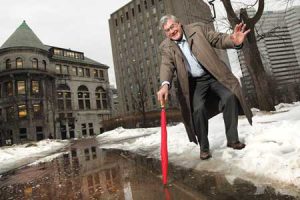
By Bud Martin
Having grown up in Edmonton in the late 1940s and early ‘50s, Lawrence Mysak fondly remembers that one sure sign of winter’s arrival: When the groundskeeper at McKernan Park took hose in hand and flooded the outdoor skating rink. A good Canadian lad, Mysak grew up playing hockey with his junior high school team. Now he’s worried that future generations won’t know those simple joys of gliding through the frosty air, or joining an after-school pick-up game of shinny with whatever ragtag group of urchins happen to be milling about the rink. His concern isn’t born of the usual handwringing over video games and sedentary lifestyles, either: It’s about the weather and climate change.
Mysak is professor emeritus in the Dept. of Atmospheric and Oceanic Sciences (AOS), and one of the co-authors of a new study that uses 55 years of meteorological data to show that climate change has put outdoor ice rinks on, well, thin ice. The study was published in the current issue of Environmental Research Letters.
The lead author is Nikolay Damyanov, who worked on the study while doing his Master’s in AOS at McGill. (He graduated last year and is now working as an applied meteorologist at AMEC, a Newfoundland engineering company.) Damyanov was looking for an applied research project to showcase his statistical data analysis chops. He approached Mysak, who in turn had gotten wind that Concordia professor Damon Matthews was wondering whether climate change has shortened the seasonal lifespan of Canada’s countless outdoor ice rinks. With funding from NSERC Discovery Grants and a Global Environmental and Climate Change Centre Scholarship for Damyanov, a research project was born.
The trio quickly discovered that they were exploring uncharted territory. Not only had there never, to the researchers’ knowledge at least, been a study of season length for outdoor ice rinks – there was no data.
“The real crunch,” says Mysak, “was deciding what the skating season is for these rinks. Nikolay did a lot of legwork. He tried to get records from rink keepers across Canada, but we were surprised to find they didn’t keep any record of what day of the year they started flooding.” It seems that generations of rink keepers, with characteristically Canadian pragmatism, simply waited until it was cold enough for a rink to freeze. Makes sense. So much sense, in fact, that the researchers adopted the same criteria.
Truncated skating season
To create a rink, you need ground that’s frozen enough that it won’t absorb water. To get that kind of ground, you need the air temperature to stay below -5° C for three consecutive days. Fortunately, Canadians’ passion for hockey is closely rivalled by our passion for recording the weather: Using 55 years worth of meticulous Environment Canada data, the researchers determined, year by year, when the outdoor skating season started in 142 locations from coast to coast to coast. They then figured out the length of the season by counting the days until the weather became too warm to support blade-worthy ice. (In the southern half of Canada, rink-keepers usually stop maintaining the ice after March 1.)
The conclusions are far from cheering: The skating season generally isn’t starting that much later than it did 55 years ago – but it is ending earlier. In some cases, as much as 15 days earlier.
“In any given year, climate events, such as El Niño, can cause fluctuations in winter temperatures,” says Mysak. “Those are normal and well-known. But what we’ve found is a clear upward trend, beyond those traditional causes, that shows there are fewer days you can skate.”
The culprit is global warming. Since 1950, Canada’s winter temperatures have increased by more than three times the global average. “Greenhouse gas concentrations in the atmosphere keep going up because of our dependency on carbon and the burning of fossil fuels,” explains Mysak, “and those increasing gas concentrations are making the air temperature warmer. It’s as simple as that.”
Canary on an ice rink?
Outdoor ice rinks aren’t just a convenient standardized bellwether of the impact of climate change. They’re also an iconic symbol of life in the Great White North – so it’s no wonder that this study, and its dire message, has garnered considerable international media play, with coverage in the Globe and Mail, Radio-Canada, CTV, CBC, the Huffington Post, Le Monde and the Guardian, among others.
Although no part of Canada is unaffected – Ottawa, for one, made headlines this year when it cut short the Rideau Canal Skateway’s season due to unseasonably warm weather – the hardest hit areas are inland British Columbia and Mysak’s home province of Alberta, which could both see a complete end to outdoor skating within a few decades. “Stephen Harper may not believe in the importance of reducing greenhouse gas emissions,” quips Mysak, “but he should believe that his grandchildren won’t be able to skate on outdoor rinks in Calgary.
“The disappearance of outdoor hockey rinks, and probably cross-country ski trails, is not going to be good for the health of our youth,” says Mysak, who stopped playing hockey at age 12 because it conflicted with his flute lessons (at 72, he still performs with the I Medici di McGill orchestra) but remained a lifelong skater and cross-country skier. “It’s very healthy to skate around in the fresh air. Lining up at 5:30 in the morning at an indoor rink just isn’t the same as walking down the street to your community outdoor rink.”
“Our future NHL superstars may come from Siberian and Finnish backyards,” he adds. “And we may see more young Canadians taking up the flute.”

Im in the process of flooding the McKernan rink in Edmonton. She looks just fine. I have some pics if you want for your research. Skating should commence next week on Monday, as long as we dont get any snow 😉